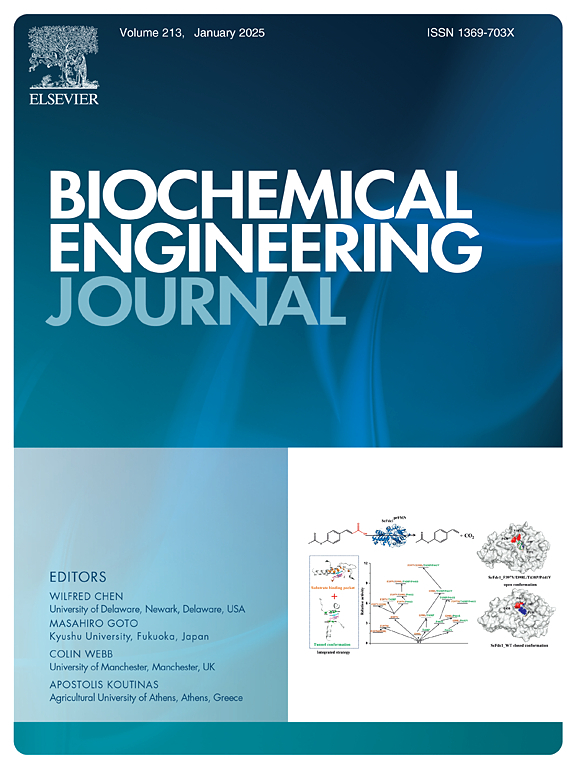Process modeling and 3-stage photobioreactor design for algae cultivation and CO2 capture: A case study using palm oil mill effluent
IF 3.7
3区 生物学
Q2 BIOTECHNOLOGY & APPLIED MICROBIOLOGY
引用次数: 0
Abstract
Microalgae have advantages, including rapid growth rates, a high lipid production capacity, effective removal of nitrates and phosphates from wastewater, and efficient carbon dioxide (CO2) absorption. The optimal operating conditions and strategies of microalgae cultivation can vary significantly from one goal to another. An economic approach to exploring various operating strategies is doable via microalgal process modeling and simulation. Therefore, this study aims to develop a simulation model aimed at enhancing algae growth within a photobioreactor (PBR) system designed to reduce CO2 emissions in palm oil mills. This simulation model is constructed to explore the algae growth CO2 capture efficiency and the influence of oxygen (O2) in the water in the PBR. This study achieved a CO2 capture efficiency of up to 60 % which represents the highest capture, and a dissolved O2 of 20 % was achieved due to the effect of the mass transfer coefficient. Algal growth exhibited a high rate, approximately 1057 g/m3, which could serve as a potential pathway for biodiesel or biobutanol production. Additionally, this study underscores the significant role of the mass transfer coefficient in effectively reducing liquid O2 levels to maximize CO2 capture and achieve a high algae yield. Furthermore, the simulation results reveal that a high concentration of O2 in the water promotes photorespiration, which hampers algal growth and reduces CO2 capture efficiency.
用于藻类培养和二氧化碳捕获的工艺建模和三阶段光生物反应器设计:利用棕榈油厂废水的案例研究
微藻具有生长速度快、产脂能力强、能有效去除废水中的硝酸盐和磷酸盐以及高效吸收二氧化碳(CO2)等优点。微藻培养的最佳操作条件和策略会因目标不同而有很大差异。通过微藻工艺建模和模拟,可以采用经济的方法来探索各种操作策略。因此,本研究旨在开发一个仿真模型,以提高光生物反应器(PBR)系统中的藻类生长,从而减少棕榈油厂的二氧化碳排放。该模拟模型旨在探索藻类生长的二氧化碳捕获效率以及光生物反应器中水中氧气(O2)的影响。这项研究实现了高达 60% 的二氧化碳捕获效率,这代表了最高的捕获效率,由于传质系数的影响,实现了 20% 的氧气溶解度。藻类的生长率很高,约为 1057 克/立方米,可作为生产生物柴油或生物丁醇的潜在途径。此外,这项研究还强调了传质系数在有效降低液态氧气水平以最大限度地捕获二氧化碳和实现高产藻类方面的重要作用。此外,模拟结果表明,水中高浓度的氧气会促进光呼吸,从而阻碍藻类生长并降低二氧化碳捕获效率。
本文章由计算机程序翻译,如有差异,请以英文原文为准。
求助全文
约1分钟内获得全文
求助全文
来源期刊

Biochemical Engineering Journal
工程技术-工程:化工
CiteScore
7.10
自引率
5.10%
发文量
380
审稿时长
34 days
期刊介绍:
The Biochemical Engineering Journal aims to promote progress in the crucial chemical engineering aspects of the development of biological processes associated with everything from raw materials preparation to product recovery relevant to industries as diverse as medical/healthcare, industrial biotechnology, and environmental biotechnology.
The Journal welcomes full length original research papers, short communications, and review papers* in the following research fields:
Biocatalysis (enzyme or microbial) and biotransformations, including immobilized biocatalyst preparation and kinetics
Biosensors and Biodevices including biofabrication and novel fuel cell development
Bioseparations including scale-up and protein refolding/renaturation
Environmental Bioengineering including bioconversion, bioremediation, and microbial fuel cells
Bioreactor Systems including characterization, optimization and scale-up
Bioresources and Biorefinery Engineering including biomass conversion, biofuels, bioenergy, and optimization
Industrial Biotechnology including specialty chemicals, platform chemicals and neutraceuticals
Biomaterials and Tissue Engineering including bioartificial organs, cell encapsulation, and controlled release
Cell Culture Engineering (plant, animal or insect cells) including viral vectors, monoclonal antibodies, recombinant proteins, vaccines, and secondary metabolites
Cell Therapies and Stem Cells including pluripotent, mesenchymal and hematopoietic stem cells; immunotherapies; tissue-specific differentiation; and cryopreservation
Metabolic Engineering, Systems and Synthetic Biology including OMICS, bioinformatics, in silico biology, and metabolic flux analysis
Protein Engineering including enzyme engineering and directed evolution.
 求助内容:
求助内容: 应助结果提醒方式:
应助结果提醒方式:


